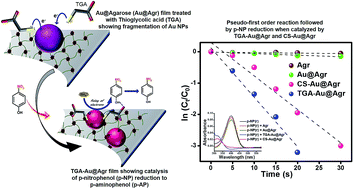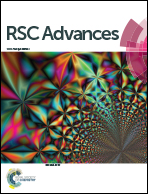Fragmentation of supported gold nanoparticles@agarose film by thiols and the role of their synergy in efficient catalysis†‡
Abstract
Thiols are known for stabilizing gold nanoparticles (Au NPs). Herein, an intriguing feasibility of a group of thiols to non-conventionally fragment supported Au NPs in the absence of any auxiliary applied energy is demonstrated. The Au NPs are studded into an agarose hydrogel film as a solid support (Au@Agr), and the group of thiols studied includes thioglycolic acid (TGA), cysteine (CS), 2-mercaptoethanol (ME), L-methionine (MET), thiourea (TU), and 1,3-propanedithiol (PDT). By simply keeping the Au@Agr film immersed into thiol solution for 1 h at room temperature, fragmented nanoparticles of much smaller sizes were obtained. Interestingly, only TGA, CS, ME and MET were found to be capable of successfully fragmenting Au@Agr. A mechanistic interpretation suggests that a prompt transfer of electron density from thiols to Au@Agr can be credited for the fragmentation behaviour of thiols. In addition, the efficacy of such a film in showing an efficient catalytic activity regulated by synergism between thiols and supported Au NPs (Au@Agr) is also presented. TGA and CS fragmented Au@Agr, i.e., TGA-Au@Agr and CS-Au@Agr films, work as an effective catalyst taking ∼20 to 30 seconds for the complete reduction of p-nitrophenol (p-NP), an industrial pollutant with sluggish removal properties. A pseudo first-order rate for the catalytic p-NP reduction reaction is followed by TGA-Au@Agr as well as CS-Au@Agr with rate constant values determined to be 1.6 × 10−1 s−1 and 1.1 × 10−1 s−1, respectively. The exclusivity of TGA and CS to swiftly catalyze p-NP reduction and also the individual role of Agr, Au@Agr and TGA/CS-Au@Agr operating in synergy for the successful catalysis was also studied in detail.


 Please wait while we load your content...
Please wait while we load your content...